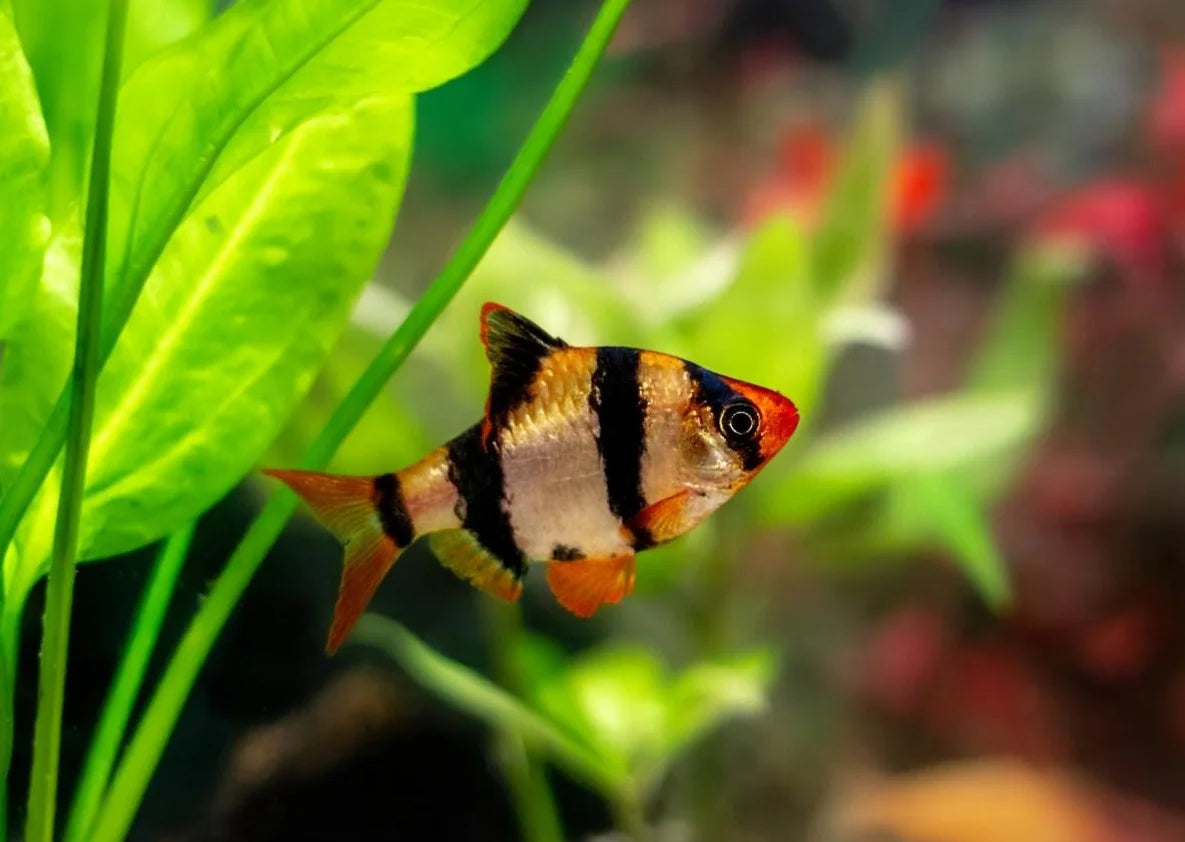1
/
of
1
Mia's Blessing Petshop
F70 Small Tiger Barb
F70 Small Tiger Barb
Regular price
$3.99 USD
Regular price
$0.00 USD
Sale price
$3.99 USD
Unit price
/
per
Couldn't load pickup availability
Key Characteristics of Small Tiger Barbs:
-
Size:
- Small Tiger Barbs typically grow to about 2 to 2.5 inches (5–6 cm) in length. When they are fully grown, they rarely exceed 3 inches (7.5 cm).
-
Coloration:
- Body Color: Small Tiger Barbs have a vibrant, light yellow to orange body.
- Stripes: They are known for their bold black horizontal stripes that run across their bodies, which give them their "tiger" appearance. These stripes are more pronounced in some fish, particularly when they are stressed or excited.
- Fin Color: Their fins are often tinged with red or orange, adding to their striking appearance.
-
Shape:
- Tiger Barbs have a slender, elongated body with a somewhat pointed head and sharp, triangular fins. The combination of their body shape and coloration gives them a lively and active appearance.
Behavior:
-
Active and Social:
- Tiger Barbs are very active fish that love to swim around in groups. They are known for their playful and energetic nature, which makes them fun to watch. In the wild, they form schools, so keeping them in groups of at least 6 is recommended to ensure they feel secure and are less likely to exhibit aggressive behavior.
-
Aggressive (Somewhat):
- While not overly aggressive, Tiger Barbs can be nippy, especially toward slower or long-finned species. Their nipping behavior may be more noticeable if they feel crowded or stressed.
- They are usually not aggressive toward fish of their own size or larger fish, but they may nip at the fins of slow-moving fish such as long-finned goldfish, angelfish, or bettas.
-
Social Structure:
- Keeping 6 or more Tiger Barbs together helps spread out any aggression and keeps them feeling comfortable in a group. When kept in smaller groups, they may become more territorial or aggressive toward other tankmates.
Care Requirements:
-
Tank Size:
- Since they are small but active, Tiger Barbs require at least a 20-gallon tank for a small school. A larger tank (30 gallons or more) is ideal for a group of 6 or more to give them plenty of space to swim and interact.
-
Water Conditions:
- Temperature: Tiger Barbs thrive in warm water, ranging between 72°F and 80°F (22°C to 27°C).
- pH: They prefer slightly acidic to neutral water, with a pH range of 6.0 to 7.5.
- Hardness: They do well in moderately hard water (6–12 dGH).
- Water Quality: Regular water changes and a good filtration system are essential, as Tiger Barbs are relatively hardy but still benefit from clean water.
-
Tank Decor:
- Substrate: Tiger Barbs are not picky about the substrate. Fine gravel or sand works well, but avoid anything too rough or sharp that could harm their delicate fins.
- Plants and Hiding Spots: While they are active swimmers, adding some live plants like Java fern, Anubias, or Amazon swords will provide hiding spots and help keep them feeling secure. They also appreciate open swimming spaces.
- Aquascaping: They will not typically uproot plants, but you should make sure any decorations or plants are securely placed, as they can be quite active and move things around.
Diet:
-
Omnivorous:
- Tiger Barbs are omnivores and will eat a variety of foods. Offer them a balanced diet that includes high-quality flakes or pellets, supplemented with live or frozen foods such as brine shrimp, daphnia, bloodworms, or worms. They also enjoy plant matter, so offering blanched vegetables like spinach, zucchini, or peas is beneficial.
-
Feeding Tips:
- Feed them small amounts 2-3 times a day. Because of their fast metabolism, it’s important to avoid overfeeding. Remove any uneaten food to maintain water quality.
Lifespan:
- Tiger Barbs typically live for about 5 to 7 years with proper care, though some may live even longer in ideal conditions.
Tankmates:
Tiger Barbs can get along with a variety of other species if they are kept with the right tankmates. Good options include:
- Other active species: Tiger Barbs do best with other active and robust fish, such as other barbs (e.g., Cherry Barbs, Rosy Barbs), small to medium-sized cichlids, and danios.
- Plecos: Many pleco species (like Bristlenose Plecos) make good tankmates because they are bottom-dwelling and will not compete for food.
- Rasboras: These peaceful, schooling fish can be great tankmates, provided they are quick enough to avoid nipping.
- Guppies: If you keep them with Tiger Barbs, be aware that guppies have long fins and may be a target for fin-nipping.
Avoid keeping Tiger Barbs with:
- Slow-moving fish: Species like betta fish, angelfish, and long-finned goldfish can be harassed by the nipping behavior of Tiger Barbs.
- Very small fish: Since Tiger Barbs are opportunistic feeders, they might nip at or even eat very small fish, especially if they are much smaller than the barbs.
Share


